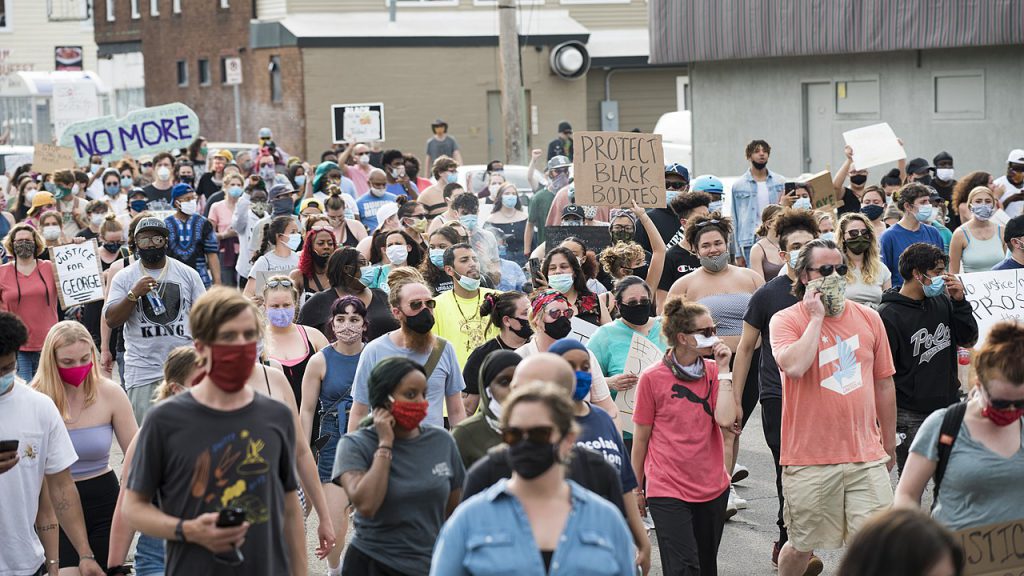
In the past week, demonstrations have erupted in big and small cities across the United States and in countries around the world over the killing of George Floyd by Minneapolis police officer Derek Chauvin.
Amid the outpouring of outrage over Floyd’s death, the killing of Breonna Taylor by a police officer in Louisville, Kentucky, and of Ahmaud Arbery by vigilantes in Georgia, along with pent-up anger, exhaustion, and fear experienced by Black, Brown, and Indigenous people facing structural racism and systemic disparities, are glimpses of solidarity and hope.
Here are some takeaways.
• Throughout Europe, across Latin America and in parts of the Middle East, protesters took to the streets in a powerful display of solidarity with U.S. demonstrators. In Brazil, people joined an existing protest against that country’s hard-line conservative president, Jair Bolsonaro. In Mexico City, portraits of Floyd were hung on the fence outside the U.S. embassy alongside flowers, candles, and signs reading, “Racism kills, here, there, and all over the world.”
• Even as President Trump threatened to deploy the military to quell what he called “domestic terror,” law enforcement in several cities stood with protesters—in some cases marching alongside them. In Chattanooga, Tennessee, the police chief told his officers to turn in their badges if they couldn’t see the injustice in Floyd’s death. And in New York City and Coral Gables, Florida, and in demonstrations in Oregon, Iowa, and Kentucky, officers took a knee alongside protesters.
• The owner of an Indian and Bangladeshi restaurant in Minneapolis, whose building had been used as a refuge for demonstrators from police mace, tear gas, and rubber bullets but was later burned down, joined in the global call for justice. His daughter, Hafsa Islam, wrote on Facebook: “Gandhi Mahal may have felt the flames last night, but our [fiery] drive to help protect and stand with our community will never die!” Quoting her father, she said: “Let my building burn. Justice needs to be served. Put those officers in jail.”
• In some cities, movements converged as monuments to the Confederacy or of statues depicting other racist historical figures became obvious targets for demonstrators. In Nashville, Tennessee, for example, protesters toppled a statue of former U.S. Sen. Edward Carmack, who supported lynching. In Richmond, Virginia, protesters set fire to the headquarters of the United Daughters of the Confederacy, a group that many have accused of furthering white supremacy.
• Colin Kaepernick, the former San Francisco 49ers quarterback who chose to kneel during the national anthem in protest of police brutality and racial inequality, is raising money to represent protesters arrested in Minneapolis. Kaepernick announced the Know Your Rights Camp Legal Defense Initiative on his Instagram page on Friday to pay for legal assistance for protesters. Nationwide, close to 5,000 people have been arrested across the country.
Meanwhile, the nonprofit Minnesota Freedom Fund, which is bailing out jailed demonstrators, raised $20 million in the first four days of the protests. The organization said it was no longer actively soliciting donations but instead encouraging people to give to the George Floyd family and other organizations run by Black community members.
• The Hands Up Act, which is an online movement collecting signatures for a petition that would force lawmakers in Washington to consider a measure that would hand down a mandatory 15-year prison sentence for any police officer who shoots an unarmed suspect. In the days since the demonstration started, he has added more than 450,000 signatures to surpass his goal of 1 million. His new goal is 1.5 million signatures.
• About 75 strangers in a Nashville community, most of them White, walked with a Black man who reached out on social media saying he was afraid to walk in his neighborhood alone. And in Louisville, White protesters lined up to form a human shield between Black protesters and local police. In the same city, Black protesters formed a circle around a White officer separated from his unit.
 |
Lornet Turnbull is an associate editor for YES!, a Seattle-based freelance writer, and a regional freelance writer for The Washington Post.
|
https://creativecommons.org/licenses/by-nc-nd/4.0/